The Blue Laced Red Wyandotte is the prettiest of the diverse Wyandotte breed of chicken. Apart from being one of the most gorgeous blue chickens in the world, the Blue Laced Red Wyandotte also stands out as a medium to top-tier production chicken with an average of 200 eggs per year.
It is said the Blue Laced Reds were created in the late 1800s, but up to date, they remain objects of fascination, attracting large crowds in shows and exhibitions for their mesmerizing blue lacing that adds a touch of iridescence to the base-rich reddish-gold feathering.
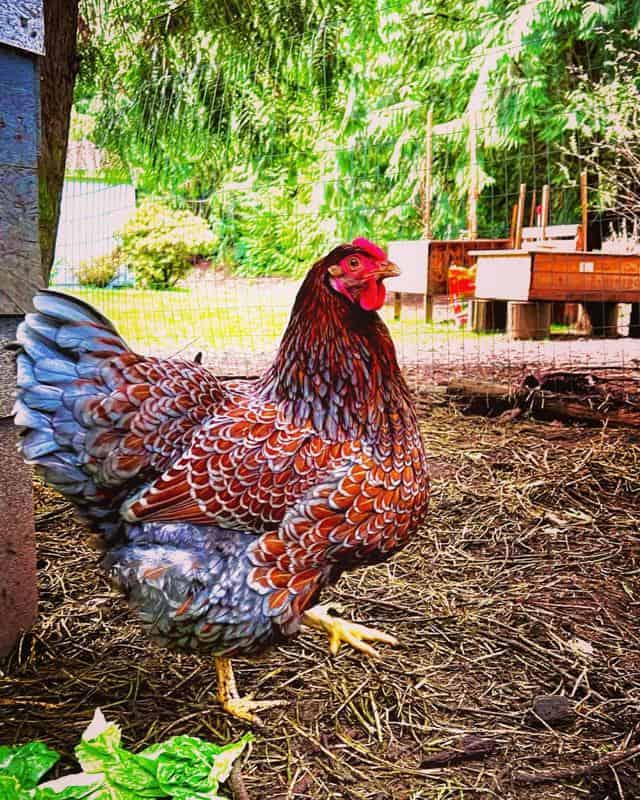
Read on to dive into the world of the most unique Wyandotte types. Get to learn the backstory behind the Blue Laced Red Wyandotte, how they get their color, their outstanding features, and if it is the right fit for you.
Blue Laced Red Wyandotte Chickens Overview
| Country of Origin | United States |
| APA Recognized | No |
| Primary Use | Dual-Purpose: Egg and Meat |
| Color | Rich reddish-gold feathering with blue lacing patterns around the edges |
| Average Weight (lbs.) | Roosters: 8.5+
Hens: 6.5+ Pullet: 5.5+ |
| Average Egg weight | Medium – Large |
| Egg Color | Light-Dark Brown |
| Egg Production Per Year | Medium-High (180- 260) |
| Temperament | Calm, Docile, Friendly |
| Ease of Care | Easy – Beginner |
| Fertility Percentage | 60 – 75% |
| Lifespan | 5+ years |
| Price per Chicken | $15 – $40 |
The Background of The Blue Laced Red Wyandotte
The origin of the Blue Laced Red Wyandotte Chicken is shrouded in a bit of doubt but it is generally understood that it started in the late 1800s in the United States.
It all began when breeders across the United States, Germany, England, and parts of Europe sought to develop a versatile dual-purpose chicken that is also a visually striking variety of the well-known Wyandotte breed.
Creating the Blue-Laced Red Wyandotte was no easy task. Breeders had to meticulously select birds with the desired traits, including the distinctive blue lacing on a rich red background. The process involved successive generations of selective breeding to refine the appearance of the chickens.
It all started with the Silver Laced Wyandotte (also known as Mooney) which was the first breed of Wyandottes, created in 1873 in the United States after the Civil War – developed from Dark Brahmas and Silver Spangled Hamburgs.
Silver Laced Wyandotte is also recognized as the first American dual-purpose chicken for meat and eggs.
According to the Standard Bred Wyandottes book written in the late 1880s and published in the Reliable Poultry Journal in 1910, it is argued that the Blue Laced Reds were created by three American Wyandotte breeders between 1886 and 1889.
By using Violet Laced Wyandotte, pure Wyandotte breeds, crossing, and re-crossing, the Blue Laced Red with golden featherings and violet blue for black lacing was born. Some were sold to England where they won various awards on their exhibition shows.
Considering how popular the blue Laced Wyandottes were in Germany during the 1920s, it would suggest that their origins were in the United States as stipulated by the journal. In fact, in 1929, the Blue Laced Red was registered in the German Standard of Perfection.
It is also believed several varieties arose from different crosses including Silver Laced Wyandottes and Golden Laced Wyandotte, between Silver Laced Wyandottes and other types like the Partridge Cochins and Silver Penciled Hamburgs.
These amalgamations have resulted in a stunning chicken adorned with intricate patterns and colors that have since captivated poultry enthusiasts.
Recognized Variety in APA and ABA
The Blue Laced Red Wyandotte is not a recognized breed of Wyandotte in breed standard organizations like the American Poultry Association (APA) or the American Bantam Association (ABA).
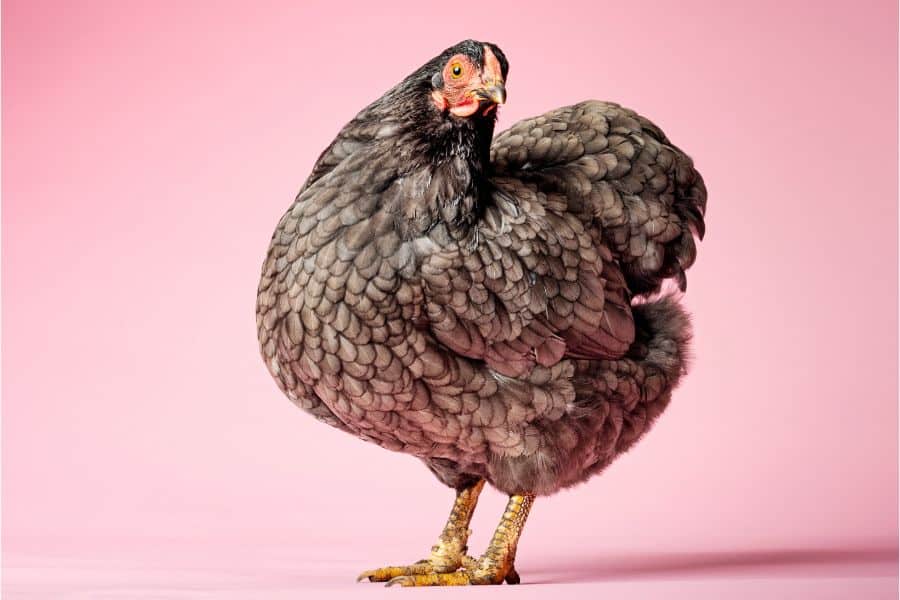
The only Blue Wyandotte on the recognized variety lists are the standard blue Wyandotte and the Blue Wyandotte bantam (according to American Bantam Association (ABA)).
Part of the reason for this is because most of the Blue Laced Red Wyandotte chicks in the market do not conform to the standard set for Wyandotte chickens.
It is also because breeders, hatcheries, and bird stores are using the name to sell many breeds that remotely resemble the real deal.
To know if the chicken you are interested in is a real blue laced red Wyandotte, ask the hatchery for information about the breeders. If the combination of the breeders actually matches what you see then it is a good choice, otherwise it would be best to wait for the real deal.
If you want to help in the standardization of the blue laced red Wyandotte then you should know of these standards set by the APA:
- 5 breeders of the Blue Laced Red Wyandotte (BLRW)
- The breeders have to have bred the BLRW for at least 5 years
- The chicken should have the same body type characteristics as other Wyandotte chickens (physique – eyes, beak, head, comb, tail, build, wings, breast, etc.)
How Blue Laced Red Wyandotte Are Developed
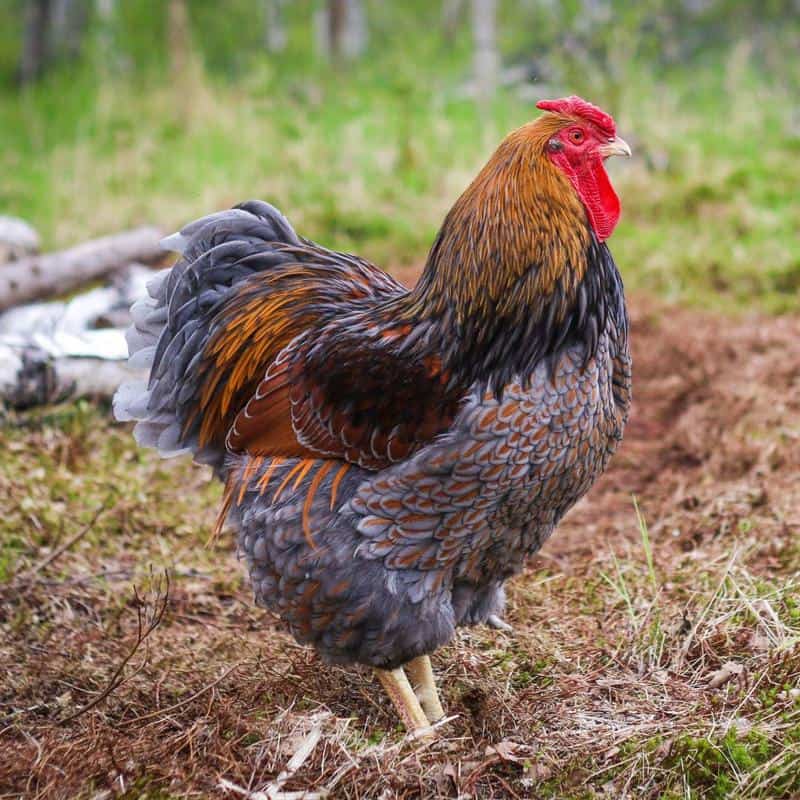
Do not worry, we are not going to go through a genetics class in this short article! Instead, we will give you an overview of how the blue laced red gets its color.
There are only three factors: The Lacing Gene, Blue genes (self-blue & diluting blue), and the Red gene.
Red Gene
Blue Laced Red Wyandotte have a deep mahogany red base feathering. It is important to note this particular red since no other red/golden color should be seen in this breed. As a way to compare, the Rhode Island Reds have a similar deep mahogany red.
The red gene is responsible for the base color of the Blue Laced Red Wyandotte’s feathers. It determines the reddish-gold color that makes the entire plumage/feathering of the thick bird.
The interaction between the red gene and the blue gene (Bl) is what creates the visually striking blue lacing effect.
Lacing Pattern Gene
The lacing pattern gene determines the presence or absence of the lacing effect – an outline running along the edges of the mahogany red feathers.
There are two lacing genes – the dominant form is responsible for the lacing effect, while the recessive form results in non-laced feathers.
For a Blue Laced Red Wyandotte to exhibit the laced pattern, it must inherit at least one copy of the dominant lacing gene from one of its parents.
Blue Gene
There are two forms of the blue gene – the self-blue gene and the diluting blue gene.
Self- blue gene is a recessive gene that is responsible for the lavender color in chickens. The lavender is often mistaken for blue and also looks grey. As a recessive gene, if you want to create blue chickens with self-blue then you need two copies of the gene, one from each parent.
The diluting blue gene is an incomplete dominant gene (you only need one copy from one parent). It is the most versatile blue color gene because it can result in the creation of a blue, black, or splash chicken.
The Blue Laced Red Wyandotte can come from several Wyandotte and other variety chickens that exhibit the above color genes. Breeding between these colors to get the perfect blue lacing and red base color is time consuming and expensive.
Blue Laced Red Wyandotte Appearance
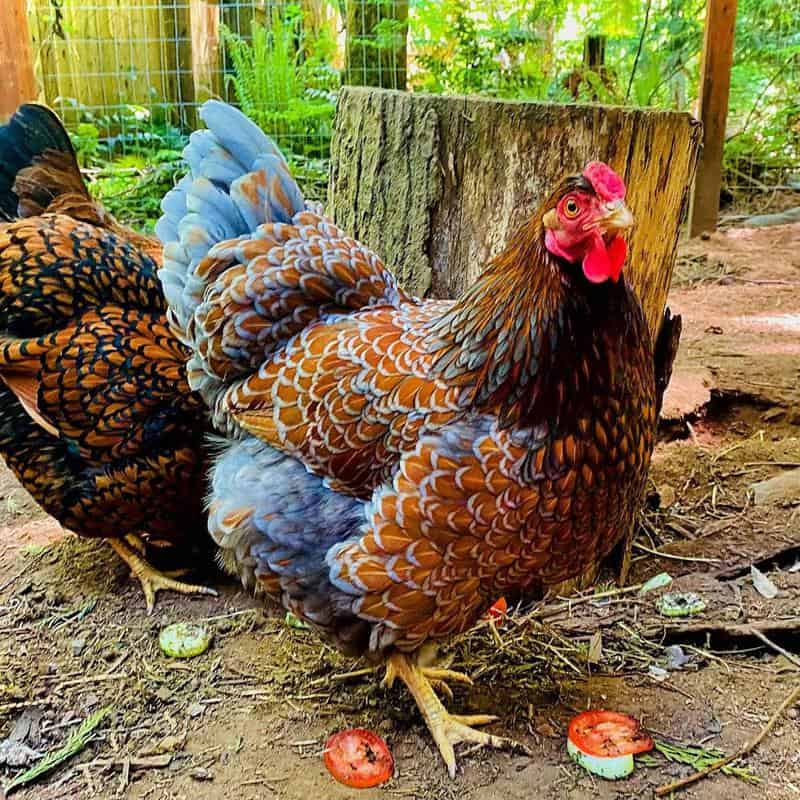
The Blue Laced Red Wyandotte is the most beautiful Wyandotte, with a mahogany red base laced with blue shades.
The Blue Laced Red Wyandotte is a medium-sized bird with a well-rounded, compact body. Its most prominent feature is the blue lacing that adorns the rich, reddish-brown/gold feathers. This intricate pattern creates a breathtaking visual display, making these chickens true eye-catchers in any flock.
So, what sets the roosters and hens of this breed apart? The key difference lies in their size and comb.
Blue Laced Red Wyandotte Roosters tend to be slightly larger (8.5 lbs. +) with a more prominent comb, while Blue laced Red Wyandotte hens are slightly smaller (6.5 lbs. +) and exhibit a more delicate appearance.
However, both showcase that majestic blue lacing and similarly thick plumage.
Blue Laced Red Wyandotte Eggs
The egg production in this breed is medium to high with about 4 eggs per week and an annual rate of 180 – 260 eggs.
As for the egg color, Blue Laced Red Wyandotte eggs are generally brown, similar to most Wyandotte varieties and many other traditional breeds. The eggshell color may vary slightly among individual hens but will typically have a light to medium brown hue.
It’s essential to keep in mind that egg color can be influenced by the breed’s genetics, and the diet of the chicken can also play a role in the intensity of the eggshell color.
It is also important to note that Blue Laced Red Wyandotte chickens generally suffer from low fertility rates. This is a defect they get from the rose comb genotype which is associated with low fertility in male chickens due to low sperm motility.
Blue Laced Red Wyandotte Temperament
Beyond their captivating looks, these chickens also have a winning personality. Blue Laced Red Wyandotte are known for their friendly, gentle, calm, and docile nature, making them an ideal choice for families and beginners alike.
They do not bully others and their gentle temperament makes handling them a breeze, and they generally get along well with other flock members.
They are okay with any eggs placed in their nests and they are great matters with a common predisposition to brooding (which many breeders might not find desirable because it means the hens can’t have more chicks).
Blue Laced Red Wyandotte Bantam
For those with limited space or simply looking for a pint-sized version of this grand breed, the Blue Laced Red Wyandotte also comes in a bantam variant.
They are only kept for ornamental purposes since their eggs are very small and also have a low production rate of about 150 eggs per year.
The male bantams are about 40 oz. while the female mature weight is 36 oz.
These miniaturized chickens still retain all the charm and beauty of their standard-sized counterparts, making them a delightful addition to any flock.
Blue Laced Red Wyandotte Care
If you have experience caring for chickens then the Blue Laced Red Wyandotte is no different.
The breed does not suffer from any unique diseases that most chickens do not face. However, you may want to keep an eye on the thick feathering that tends to attract lice and mite infestations. This is because the dense feathering attracts poop, dirt, and other accumulations on the hens’ bodies.
Blue Laced Reds are hardy chickens that can withstand heat and easily handle cold weather. Like other Wyandotte chickens, their thick feathering is not only a downside but an upside that keeps their temperature stable and fights cold temperatures.
As with short rose combs in chickens, the Blue Laced Reds can fight frostbites easily, making them one of the best breeds to raise in the upper states.
Price for Blue Laced Red Wyandotte
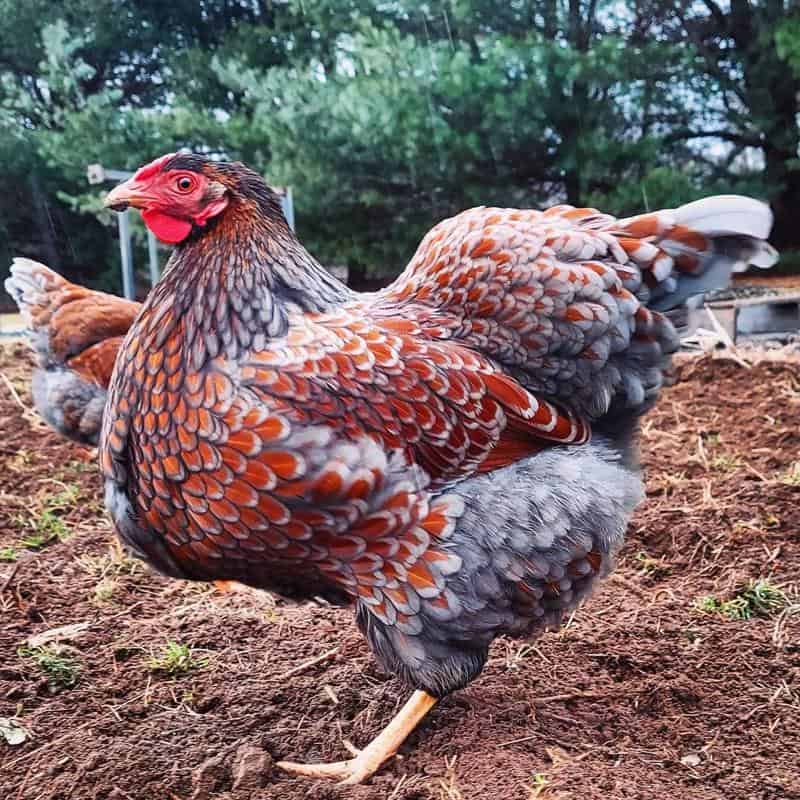
Considering how rare this bird’s color is, do not be surprised when you go to buy one and find a whopping $40 per chicken price tag.
Yes, the Blue Laced Red Wyandotte chickens are expensive, costing about $15 – $40 per chicken.
However, you can get the BLRW for less than $10 from hatcheries and private breeders. One thing to keep in mind in these cases is that the cheaper ones are of lower quality and are a result of less efficient breeding methods.
Only go for inauthentic Blue Laced Reds if you only want the color and are not planning to breed the chicken.
If you want a chicken to keep for longer or breed then you might be sacrificing a lot since the fake ones usually have bad body posture, defects like lower fertility levels, and generally shorter lifespans.
Also Read:
Blue Laced Red Wyandotte: FAQs
Are Blue Laced Red Wyandotte Rare?
Blue Laced Red Wyandottes are rare compared to some more common chicken breeds. However, their popularity has been steadily increasing due to their striking appearance and friendly temperament.
Regardless, they still remain an expensive type of chicken to breed because of their unique colors which are harder to create.
Another reason why they are rare is the low fertility rate linked to the rose comb gene.
If you are interested in adding Blue Laced Red Wyandottes to your flock, it’s a good idea to check with local breeders, hatcheries, or poultry shows to inquire about their availability.
Breed-specific clubs and online forums can also be helpful resources to connect with breeders who specialize in this particular variety.
What Is the Rarest Wyandotte Chicken?
Even though the Blue Laced Red Wyandotte is rare, its sister breed the Chocolate Laced Wyandotte is considered the rarest of the Wyandotte Family.
The Chocolate Laced Wyandotte features a rich, chocolate brown color with intricate lacing patterns around the edges of its feathers. The combination of its distinct color that is hard to breed to life and the popularity of Wyandotte chickens, in general, contributes to its rarity.
Conclusion
So, whether you’re a poultry enthusiast, a backyard chicken keeper, or simply someone intrigued by nature’s marvels, consider adding the Blue-Laced Red Wyandotte to your flock, and let its captivating beauty and amiable nature leave you in awe every day.
If you happen to own one then you may want to consider taking your hobby an extra step and breeding the chickens for up to 5 years. This way, you may be able to contribute towards the eventual recognition of the breed under the American Poultry Association.
